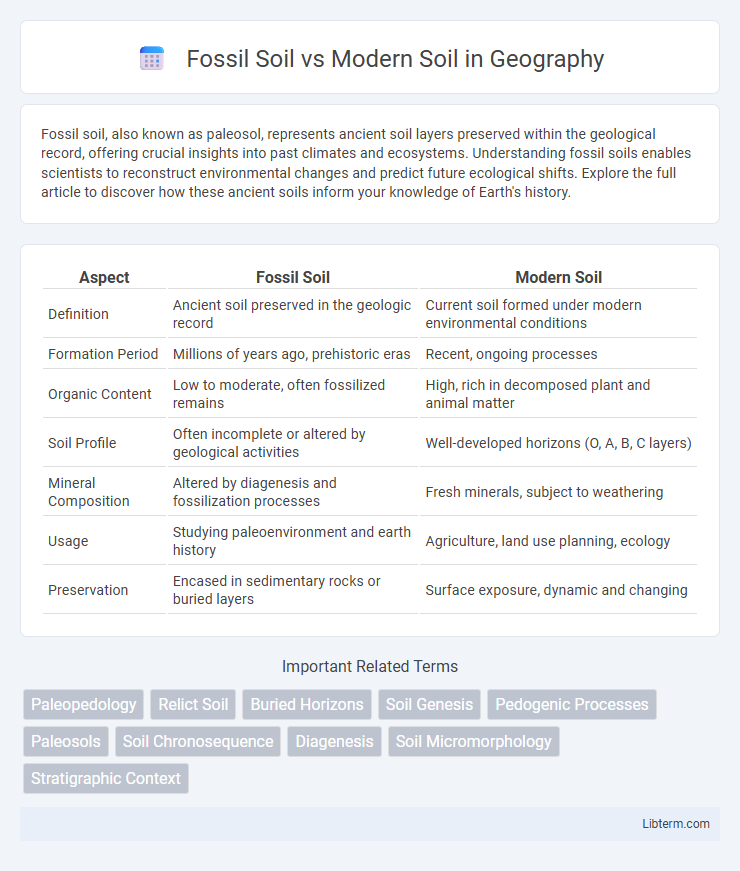Fossil soil, also known as paleosol, represents ancient soil layers preserved within the geological record, offering crucial insights into past climates and ecosystems. Understanding fossil soils enables scientists to reconstruct environmental changes and predict future ecological shifts. Explore the full article to discover how these ancient soils inform your knowledge of Earth's history.
Table of Comparison
| Aspect | Fossil Soil | Modern Soil |
|---|---|---|
| Definition | Ancient soil preserved in the geologic record | Current soil formed under modern environmental conditions |
| Formation Period | Millions of years ago, prehistoric eras | Recent, ongoing processes |
| Organic Content | Low to moderate, often fossilized remains | High, rich in decomposed plant and animal matter |
| Soil Profile | Often incomplete or altered by geological activities | Well-developed horizons (O, A, B, C layers) |
| Mineral Composition | Altered by diagenesis and fossilization processes | Fresh minerals, subject to weathering |
| Usage | Studying paleoenvironment and earth history | Agriculture, land use planning, ecology |
| Preservation | Encased in sedimentary rocks or buried layers | Surface exposure, dynamic and changing |
Introduction to Fossil Soil and Modern Soil
Fossil soil, also known as paleosol, represents ancient soil layers preserved within geological formations and provides valuable insights into past climates and ecosystems. Modern soil, by contrast, is the uppermost, active layer of the Earth's surface that supports current plant growth and undergoes continuous processes of weathering and organic matter decomposition. Understanding the distinctions between fossil and modern soils helps reconstruct historical environmental changes and informs soil development dynamics in present ecosystems.
Defining Fossil Soil: Characteristics and Origins
Fossil soil, also known as paleosol, is an ancient soil horizon preserved within the geological record, providing valuable insights into past climatic and environmental conditions. Its defining characteristics include altered mineralogy, distinct coloration due to weathering processes, and the presence of root traces or organic matter indicative of prehistoric vegetation. These soils originate from prolonged periods of soil formation followed by burial under sedimentary layers, preventing further modification and allowing detailed study of Earth's historical landscapes.
Modern Soil: Properties and Formation Processes
Modern soil exhibits dynamic properties such as high nutrient availability, active microbial communities, and well-developed structure due to continuous inputs of organic matter and mineral weathering. Formation processes involve complex interactions including physical weathering, chemical alteration, organic matter decomposition, and bioturbation driven by plants and soil fauna. These processes result in distinct soil horizons characterized by varying textures, compositions, and biological activity that support diverse ecosystems and agricultural productivity.
Geological History Encoded in Fossil Soils
Fossil soils, also known as paleosols, preserve ancient soil horizons that reveal critical information about past climatic conditions, vegetation, and geomorphological processes. These soils contain mineralogical and chemical signatures, such as stable isotope ratios and organic carbon content, which provide insights into Earth's paleoenvironmental changes over millions of years. Modern soils, by contrast, continuously evolve under current climate and biological activity, lacking the deep-time historical record embedded in fossil soils and thus playing a different role in interpreting geological history.
Biological Activity in Modern Soils
Modern soils exhibit significantly higher biological activity compared to fossil soils, driven by active microbial communities, root respiration, and organic matter decomposition. This enhanced biological function supports nutrient cycling, soil structure formation, and carbon sequestration, contributing to ecosystem productivity and soil fertility. Fossil soils lack ongoing biological processes, resulting in reduced microbial diversity and limited biochemical transformations.
Chemical Composition: Fossil vs. Modern Soils
Fossil soils, or paleosols, exhibit chemical compositions distinct from modern soils due to prolonged diagenetic processes and mineral transformations over geological timescales. They often contain higher concentrations of stable minerals like quartz and clay minerals, with diminished organic matter and soluble nutrients compared to modern soils, which reflect active biological cycling and fresh mineral inputs. Elemental profiles of fossil soils show enrichment in iron and aluminum oxides indicative of weathering and soil horizon development under ancient climatic conditions.
Soil Horizons and Stratification Differences
Fossil soils, or paleosols, exhibit distinctly altered soil horizons compared to modern soils due to long-term geological and diagenetic processes, often resulting in compressed or mineral-replaced layers that obscure original horizon boundaries. Modern soils typically display clear stratification with well-defined O, A, E, B, and C horizons reflecting current biological activity, organic matter accumulation, and weathering profiles. In contrast, fossil soils show disrupted or merged horizons where features such as illuviated clay layers or organic horizons are partially lost or indurated, providing key paleoenvironmental indicators.
Role in Understanding Past Climates and Ecosystems
Fossil soils, also known as paleosols, provide critical information about past climates and ecosystems by preserving chemical and biological signatures from ancient environments, such as carbon isotopes and mineral compositions that reveal atmospheric conditions and vegetation types. Modern soils reflect current climate and biological activity, serving as a baseline for comparing changes in soil formation processes and ecosystem dynamics over geological timescales. Analyzing differences between fossil and modern soils helps reconstruct paleoclimate variability and ecosystem evolution, informing models of climate change impact and biogeochemical cycling.
Human Impact on Soil Evolution
Fossil soils, or paleosols, reveal historical soil conditions before extensive human alteration, providing baseline data for natural soil evolution over millennia. Modern soils exhibit significant changes due to agriculture, deforestation, urbanization, and pollution, which have accelerated erosion, nutrient depletion, and contamination. Understanding the contrasts between fossil and modern soils highlights the profound impact of human activities on soil structure, composition, and fertility, essential for sustainable land management and conservation strategies.
Implications for Agriculture and Conservation
Fossil soils, or paleosols, offer critical insights into past climate conditions, informing modern agricultural practices by revealing long-term soil formation and nutrient trends. Modern soils, shaped by recent environmental factors and human activity, often exhibit depletion or altered microbial communities, challenging sustainable crop production and soil conservation. Understanding the differences between fossil and modern soils aids in developing strategies to enhance soil fertility, prevent erosion, and promote biodiversity conservation in current agricultural landscapes.
Fossil Soil Infographic

 libterm.com
libterm.com